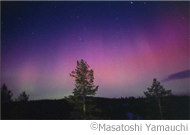|
 |
|
Northern Lights in Kiruna, Sweden close to
midnight on April 6, 2000.
|
|
|
|
Improved vacuum pumps were one
of the spin-offs of the railway revolution: the
discovery of X-rays and the arrival of "post steam"
technology depended on this apparently mundane fact.
When the pioneers passed electric current through
gases at lower and even lower pressures, a rich
variety of effects occurred. First William Crookes
noticed that the nature of the colored lights changed
as the pressure was reduced. In these circumstances
the atoms in the gas emitted light much as the Aurora
Borealis or "Northern Lights" are stimulated by
electrically-charged high energy particles, cosmic
rays, hitting the upper atmosphere. The high
atmosphere is rarefied, and vacuum technology
produces a similar thin gas in the Crookes tubes. The
ghostly shimmer of the aurora in a glass tube is
eerie even when you know what it is and to Victorian
scientists working in the dark, in all senses of the
phrase, it was unnerving. Crookes had become involved
with spiritualism following the death of his brother.
Seeking a scientific proof of the soul, he became
obsessed by the subtle lights in his tubes. Convinced
that during seances he had seen "luminous green
clouds" and that the lights in the tube were the same
as these phantoms, he announced that he had produced
ectoplasm.
|